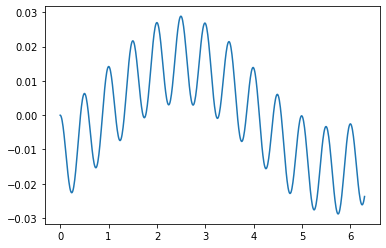[9]:
import quanguru as qg
import numpy as np
import matplotlib.pyplot as plt
14 - Time dependent Hamiltonian#
In previous tutorials, the system Hamiltonians were time independent, and QuanGuru provides couple different methods to describe and simulate time-dependent Hamiltonians. In this tutorial, we demonstrate one (probably the most convenient and flexible) of these time-dependent Hamiltonian methods.
Here, we use the below single qubit Hamiltonian,
\(H=f_{z}J_{z} + f_{x}(t)\sigma_{x}\)
where the second term will be time dependent.
[10]:
qubFreq = 1
driveFreq = 2
driveAmp = 1
drivePhase = 0
couplingStrength = 1
OmegaR = couplingStrength*driveAmp
detun = qubFreq-driveFreq
Omega = np.sqrt((OmegaR**2) + (detun**2))
[11]:
qub = qg.QuantumSystem(operator=qg.Jz)
qub.dimension = 2
qub.frequency = qubFreq
# add the drive terms
secondTerm = qub.createTerm(operator=qg.sigmax)
secondTerm.frequency = driveFreq
qub.initialState = 1
qub.simTotalTime = 2*np.pi
qub.simStepSize = 0.01
# create the operators for which we compute the expectation values
sigmaX = qg.sigmax()
# write a compute function that takes two arguments: (i) a quantum-system (qsys) and (ii) a state
# compute whatever we want and store in .resultsDict
def compute(qsys, state):
qsys.resultsDict['sigmax expectation'].append(qg.expectation(sigmaX, state))
# set the compute attribute of our qubit to compute function
qub.compute = compute
[12]:
def secondTermTime(st, ti):
st.frequency = couplingStrength*driveAmp*np.cos(2*np.pi*driveFreq*ti + drivePhase)
secondTerm.timeDependency = secondTermTime
[13]:
states = qub.runSimulation()
[14]:
qub._freeEvol.numberOfExponentiations, len(qub.simulation.timeList)
[14]:
(1258, 630)
[15]:
plt.plot(qub.simulation.timeList, qub.resultsDict['sigmax expectation'])
[15]:
[<matplotlib.lines.Line2D at 0x20f72eba5b0>]

[ ]: